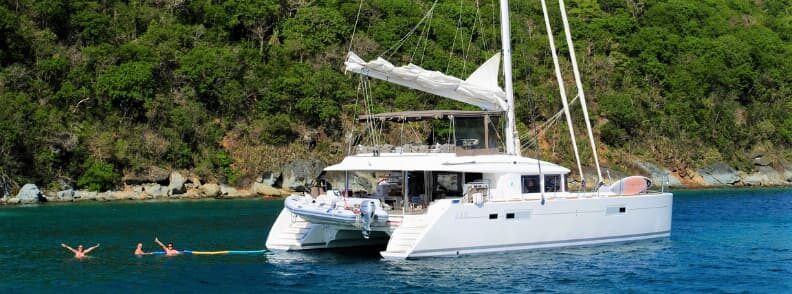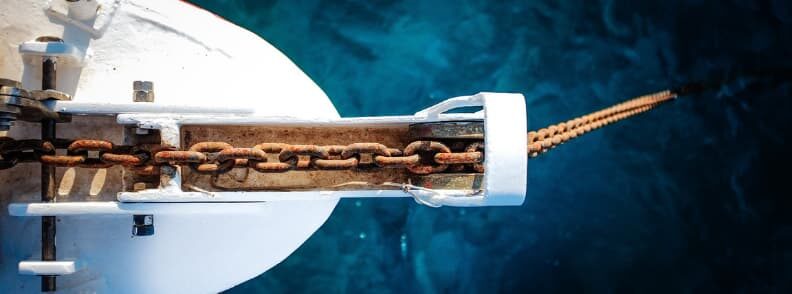Sailing from island to island is the best way to take a holiday and unwind. And there’s something special about renting a boat and sailing the Caribbean’s pristine, turquoise waters. However, at some point throughout your Caribbean sailing adventure, you will want to come to a halt. You’ll need to find an anchorage and either anchor or use a mooring ball if you wish to fish, swim, snorkel, dive, have lunch or remain overnight.
One of the most fundamental tasks in boating is securing a boat. The idea is to plan ahead and move slowly.
Also, don’t feel ashamed if you miss the first time. There isn’t a single seasoned sailor on the water who hasn’t run into this issue. Simply turn around and begin again your manoeuvre. What matters is that you get it right! If you don’t, not only are you putting your boat at risk, but you may also bring harm to the other vessels anchored nearby.
If you follow these Caribbean sailing tips and practices, you can rest assured that your anchoring will be secure and hassle-free!
Disclosure: Some of the links below are affiliate links. This means that at no extra cost to you, The Travel Bunny will earn a small commission if you click through and make a purchase. Thank you!

Choosing an anchorage on your Caribbean sailing vacation
Picking an anchorage is the first step in anchoring. Arrive at your anchorage as early as possible in the afternoon. This provides adequate light to avoid shoals and other hazards such as rock/coral heads, fishing nets or boats, ferries, freighters, mooring balls, crab pots, and cables. Furthermore, many famous places around the Caribbean get quite congested during the peak Caribbean sailing season (December to April). By arriving early, you’ll secure a good spot or have additional time to go somewhere else before dusk if needed.
There are various factors to consider while choosing where to anchor during your Caribbean sailing trips. Here are some probing questions that can help you:
- Is the anchorage secure?
A proper anchorarge for your Caribbean sailing vacation will provide shelter from the current weather conditions as well as the weather that is predicted. Is there any local weather (wind) or swell exposure that would make this anchorage too shaky? How well is the area marked or charted? - What is the tidal range and depth?
It’s crucial to have enough depth so that low tide doesn’t offer obstructions for your boat to hit, and it’s also important when deciding scope for anchoring on your Caribbean sailing vacation. - What is the quality of the grip?
The type of sea bottom should be shown on charts. Most anchors will hold well in sandy bottoms, in general. Anchors cannot bore into rock, coral, or shale. If at all possible, stay away from grassy bottoms where anchoring is difficult. - Is the anchorage crowded, noisy, filthy, or stinky?
Is the beach bar’s band going to keep you up until the early hours of the morning, or will the diesel smell of the inter-island boat distract from your perfect fragrance of paradise? Will staying here enhance or ruin your Caribbean sailing experience? - How is the area?
When you’re sitting in the cockpit, watching the sunrise or sunset, how beautiful is the anchorage? Is there a good area to dock the dinghy and how long is the dinghy journey to shore? What services are accessible on the beach? - Finally, is there sufficient space?
The widest feasible swing range should be considered regardless of where your boat is anchored.
Anchoring when you’re sailing the Caribbean
Getting ready to drop anchor during your Caribbean sailing excursion
Once you’ve found an anchorage and you’ve decided it’s the best place to stop on your Caribbean sailing tour, there are a few things to do before actually dropping the anchor:
- Work out a communication method between the person at the helm and the crew member dropping the anchor before doing anything else. Keep in mind that while your engine will be running, you’ll be unable to communicate vocally unless you shout, and that’s usually frowned upon by those who will become your neighbors for the night. Hand gestures are frequently the most effective.
- Before approaching the anchorage, furl the sails and generally make the boat ship-shape. If you’re dragging the dinghy behind you, shorten its line. When you put the engine in reverse, this keeps it from being pulled into the prop. Another option is to tie it to a port or starboard cleat.
- If your anchor has a safety line attached to the chain (typically seen exclusively on monohulls), untie and remove it from the anchor locker gate.
- Disconnect the anchor from the bow rollers and prepare it to be lowered. This is accomplished by lowering the anchor two to three feet using the electrical remote-controlled windlass (available on most Caribbean yacht charters). Make sure all of your fingers and toes aren’t caught in the chain!
- Finally, do a very slow tour around the anchorage to get a sense of where you want to be.
Dropping and setting the anchor on your Caribbean sailing tour
Pick your spot after your tour of the anchorage. You must anchor as the newest arrival in an anchorage to avoid colliding with other vessels already anchored. Allow for the possibility of a change in wind direction – it’s generally a good idea to allow some additional room around your boat. Make sure you’ll have enough area to fall back on the anchor without getting too near to any vessels anchored behind you in case all of you will need to use a 7 to 1 (chain length to depth) ratio later. If you’re using the entire chain in typical conditions, a safe minimum anchor scope ratio is 5 to 1.
The scope ratio is 7 to 1 in bad weather. The height from the water line to the bow roller is equal to the depth of the water at high tide plus the height from the water line to the bow roller. When the boat is safely moored, the scope is the actual quantity of anchor line (chain) paid out. If high water is 20 feet deep and your bow roller is 5 feet above the water, you’ll need 125 feet (5 x 20 + 5 feet) of scope to anchor with the entire chain, or 175 feet with a 7-to-1 scope. Remember that one of the most common mistakes cruisers make while anchoring is using too little chain.
Slowly approach the chosen location with the bow facing the breeze. Stop the boat exactly where you want the anchor to be placed and measure the depth.
If you’re chartering a catamaran, keep in mind that it has less resistance to the water than a monohull and hence takes longer to slow down. Check to see if the catamaran has come to a complete halt. Using both engines at idle speed, you can maintain a cat straight into the wind. It’s time to drop and set the anchor once your vessel has lost all forward movement.
Despite the phrase “dropping anchor”, you should never toss the anchor over the side or let it run free since the chain will rush out at a terrific pace and pile up on itself instead of lying down straight on the sea bed. A stacked anchor chain inhibits the anchor from properly setting and may even dirty it. Instead, use the windlass to swiftly drop the anchor to the bottom. Allow the wind to gently propel your boat backward instead of reversing.
As the ship goes aft, let out enough chain. You don’t have to worry about being broadside to the wind if you’re in a monohull. Snub the chain and let the wind straighten out the boat once the desired amount of chain has been let out.
Put the engine in reverse and throttle at 1500 rpm’s for roughly 15-20 seconds once the boat is heading with the bow into the wind. The anchor should now be set, and the anchor chain should begin to straighten. Pay out some more chain if it rattles or skips. The chain will not shake when the anchor is properly set.

Turn off the engine after you’re sure the anchor is secure. Put on your snorkeling gear and inspect the anchor visually to make sure your boat is secure. Reset the anchor if it’s on its side and entangled in coral, or if the chain is twisted around a coral head.
Look around for reference points in relation to your boat after the anchor is securely in place. Other boats or stationary features like houses, rock structures, or towers can be included. Relax in your cockpit for the next hour and double-check that all of your reference points are in the same position. You’re probably dragging the anchor if this isn’t the case.
Use a mobile app while dropping anchor to set an anchor alarm. It’s usually easier to use and more accurate than reference points, allowing you to better relax on your Caribbean sailing trips.

Dealing with a dragging anchor during your Caribbean sailing cruise
It’s not a huge issue if your boat drags anchor during the day. Just start your engine and shift to the idle position. Make an effort to let out more of the chain. Wait a few minutes to check if the anchor will automatically set. Otherwise, you’ll have to re-anchor.
It gets a little more difficult if your boat drags at night. If you are deep asleep and don’t bump into anything, you may not realize you have been moving until you wake up in a new location the next morning. I have sailor friends that have a lot of experience. After a night of dragging, they woke up in a completely new anchorage!
Other individuals in the anchorage, on the other hand, may help you become aware of night dragging when they start yelling and flashing lights at your boat. Like when dragging the anchor during the day, start your engine and let it idle for a while. Release more of the chain and wait for the anchor to reset. Otherwise, you’ll have to re-anchor.
Use your depth sounder to look for a new place to anchor. To achieve the finest night vision, turn off all of the lights aboard the boat (except the ones you need for safety purposes). Slowly and carefully travel to another location.
Try to catch your neighbor’s attention if their boat is dragging during the day. To prevent damage to your boat, put out fenders. If no one is on board the dragging boat (they’re on the beach partying at the local beach bar), you may either climb aboard and reset the anchor, or you can move your own boat if you’re not comfortable doing so.
Keep in mind that it’s not always a good idea to go aboard an empty boat with a dragging anchor because there have been cases where the saviors got sued by ungrateful owners for trespassing. If you have access to the internet on your Caribbean sailing trip, I’ve seen people posting a warning on Facebook sailing groups for that specific region, in the hope that the owner is a member or he’s known by somebody in the group.
In my personal opinion, it’s a good idea to stay around to observe the situation and to intervene if there’s an emergency, and try to issue a warning via VHF and on Facebook. Maybe call the coast guard for advice. Because if you get on board you might discover the electricity is turned off and it might be close to impossible for you to set up their anchor manually without increasing the risks. In a worst-case scenario, I’d rather anchor close and secure their boat to mine — obviously, if their boat is not some heavy mega-yacht.
If you’re startled awake in the middle of the night when another boat collides with yours, instantly start the engine and keep it idle. Wake up the other boat’s crew (yell, flash your lights, etc. ) and proceed as usual. Hopefully, the damage to your boat is minimum thanks to the fenders you put out earlier.
Weighing anchor to continue your Carribean sailing adventure
Preparation is required once more before you raise the anchor:
- Make sure any loose things are tucked away and that the hatch covers are shut. (The hatch lid on the anchor locker should be open, though.)
- Reduce the length of the dinghy line or move it to the side once more.
- Turn on the engine. (To operate the windlass on most charter boats, the engine must be running.)
- With the windlass remote control in hand, have a crew member stand on the bow’s most forward position. The crew member orders the helmsman to propel the boat forward gently in the direction of the chain, using hand gestures. Make sure the helmsman brings the boat to a complete stop before overshooting the anchor.
- Start tightening the chain while it’s still slack.
- Put the remote control down and remove the snubber when you come to it. Then start cranking again.
- Instruct the helmsman to steer the boat ahead in the direction of the chain once the chain is taut again, using hand gestures. The goal is to avoid using the windlass to propel the boat ahead since it puts a lot of strain on the windlass and the chain roller.
- The boat will be directly above the anchor at one point. Continue to spin the chain until the anchor is fully raised and seated on the rollers.
- The helmsman should be notified that the boat is now free. If the anchor chain has a safety line, reattach it to the anchor chain, stow the remote control, and secure the anchor locker gate.
- Return to the cockpit to assist in raising the sails.
Using mooring balls when sailing in the Caribbean
A mooring ball is a buoy that is attached to a massive anchor or weight. Professionally maintained mooring balls are placed in numerous anchorages around the Caribbean, but mainly in the British Virgin Islands, and are available for overnight use for a nominal price.
Mooring ball advantages
Picking up a mooring ball on your Caribbean sailing trip offers three additional benefits in addition to safeguarding the coral from harm caused by an anchor:
- You don’t need to use your anchor.
- The mooring’s anchor will almost certainly never drag.
- Because the mooring’s anchor is so heavy and thoroughly embedded in the seabed, there is less scope required, and the boat will swing about in a tighter radius than if it were on its own anchor.
How to use a mooring ball on Caribbean sailing holidays
Approach the mooring location gently, with your dinghy towed in on a short painter or on a side cleat, just as you would when anchoring. Have a crew member ready to lead you and take up the mooring pennant using the boat hook at the bow (a line with a loop at the end). Attach one end of a line to a bow cleat and keep the other end close by. One line is sufficient if you have chartered a catamaran. Attach a second rope to the opposite side bow cleat if you’ve chartered a monohull.
Slowly approach the mooring ball, pointing the bow of the boat into the breeze. You may cruise approach the ball by moving from forward to neutral alternatively. As the crew member lifts the pennant on board and passes the free end of the line(s) through it, shift into reverse to bring the boat to a complete halt.
For a catamaran, cleat off the free end of the line on the opposite bow cleat; for a monohull, cleat off the free end on the same side. The two lines on a monohull avoid chafing and reduce the chance of breaking free from the mooring ball. The rope hangs low enough on a catamaran that chafing from tension is rarely an issue.
Again, don’t be ashamed if you forget to pick up the pennant the first time; we’ve all done it! Simply go around in a circle and do it again. If required, adjust the lines once they’ve been fastened.
Make sure the dinghy is on a short painter or on a side cleat before leaving a mooring ball. Simply untie the line(s) and release the pennant. When leaving for your next Caribbean sailing location, be careful not to run over the mooring buoy and pennant!
You’ll want to stop somewhere along your Caribbean sailing expedition, no matter where it leads you. While sailing, anchoring is one of the most critical things you’ll do. Anchoring is both a science and an art. The helmsman and crew must work with the wind, current, and vessel to coordinate their efforts.
The most essential thing to keep in mind is to avoid feeling ashamed at any point. Even the most seasoned sailors have trouble anchoring on occasion. “Practice makes perfect”, as the old saying goes.

Mirela Letailleur is a Romanian travel blogger living in the South of France. She writes on The Travel Bunny travel blog about affordable travel in Europe, creator of unique free travel guides, local travel expert. Problem solver. Wannabe coffee guru.
More articles to help you plan your Caribbean sailing trip or other adventures
Bahamas yacht charter to sail the Caribbean Sea
Croatia Sailing Vacation Tips & 3 Best Sailing Destinations
Guide to sailing the Cyclades Islands in the Aegean Sea

